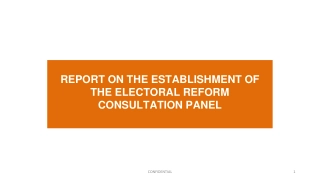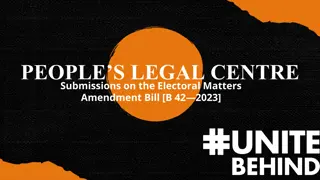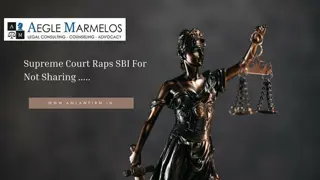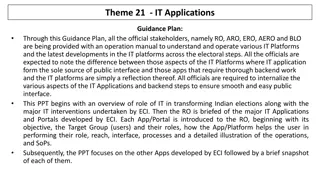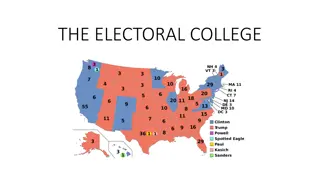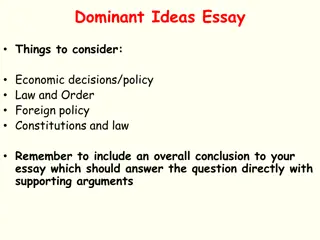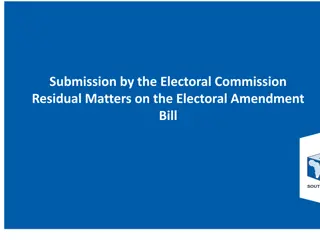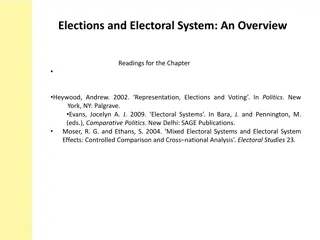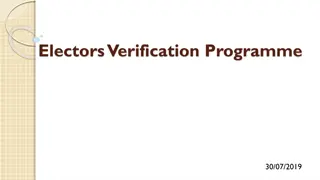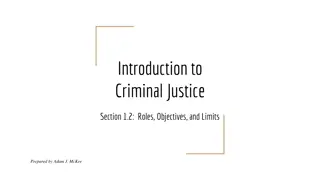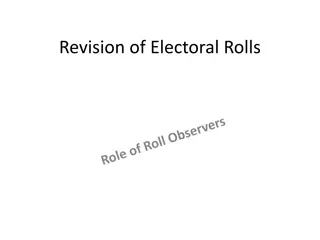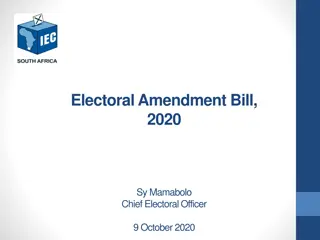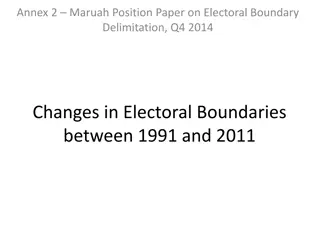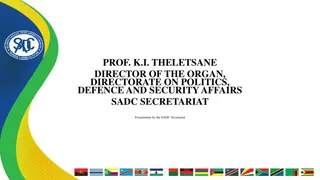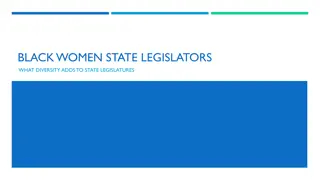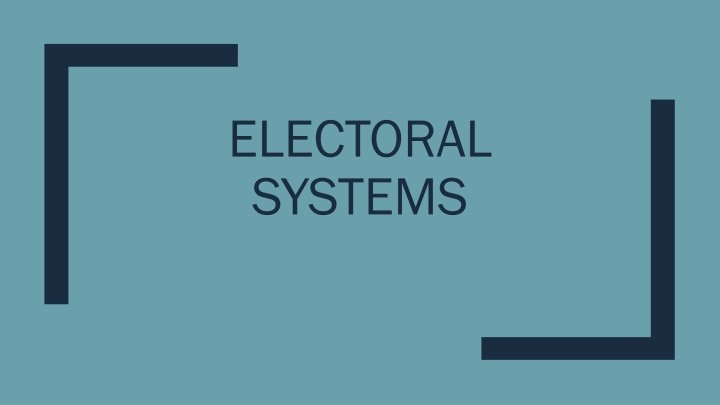
Electoral Systems: First Past Post vs Proportional Representation
Explore the differences between First Past Post and Proportional Representation electoral systems, including their pros and cons, impact on voter representation, and governance outcomes. Understand how these systems determine the allocation of legislative seats based on voter preferences and the implications for democracy.
Download Presentation

Please find below an Image/Link to download the presentation.
The content on the website is provided AS IS for your information and personal use only. It may not be sold, licensed, or shared on other websites without obtaining consent from the author. If you encounter any issues during the download, it is possible that the publisher has removed the file from their server.
You are allowed to download the files provided on this website for personal or commercial use, subject to the condition that they are used lawfully. All files are the property of their respective owners.
The content on the website is provided AS IS for your information and personal use only. It may not be sold, licensed, or shared on other websites without obtaining consent from the author.
E N D
Presentation Transcript
ELECTORAL SYSTEMS
First Past Post Division into districts Every voter chooses their top candidate Usually--whichever candidate receives the most votes, wins (plurality) Sometime whichever candidate receives the majority of votes, wins (majority) This will require a run-off election between two candidates if no one gets a majority
First Past Post. (Winner take all) Positives Creates stability with one party in charge of legislature, or government (parliamentary systems) Creates broad parties reflecting a large cross-section of the public Creates two dominant parties that compete for centrist voters System is easy to understand, implement and inspect Direct accountability to electorate Criticisms Does not reflect the wide spectrum of voter issues and interests Larger parties and parties with broad appeal and support get a disproportionate share of the seats in government (often does not reflect popular vote)
First Past Post. Seats Parties with over one seat, for Great Britain only Seats % Votes % Votes Labour Party 355 56.5 36.1 9,552,436 Conservative Party 198 31.5 33.2 8,782,192 Liberal Democrats 62 9.9 22.6 5,985,454 Scottish National Party 6 1.0 1.6 412,267 Plaid Cymru 3 0.5 0.7 174,838 Others 4 0.6 5.7 1,523,716 628 26,430,908
Proportional representation People vote for their party OR candidate (or both Mexico) and the legislative seats are assigned according to percentage of vote There is usually a threshold, ie. If you have less than 5% of the vote, your seats go to the leading party (Russia changed from 5 to 7 and then back to 5 to solidify United Russia s position)
Proportional Representation Positives Theory is increased voter turnout More accurately represents the results of the popular vote Creates more parties with more specific platforms/goals More parties leads to more collaboration on legislation Complaints Instability in parliamentary democracies, coalition governments are more likely In presidential democracies, it can confuse agenda or legislature Calculation and transparency can be more difficult . Less direct accountability to constituents
Proportional Representation Russia, 2017
Generally, how does the electoral system influence the political parties that form?
Great Britain House of Commons 650 members Individual districts, first past post system Candidates selected by the party to run in each district (no necessarily from district) Fixed term parliament act of 2011 means cannot serve MORE than 5 years House of Lords Currently 788 seats-not fixed Members are appointed Lords spiritual (26 appointed by church of England) Lords temporal (90 inherited, others appointed by Queen or government) Formerly all were inherited Only upper house larger than lower house, much less power than Commons
Great Britain--Parties Two Dominant Parties Labour Conservative & Unionist Regional Parties Scottish National Party Democratic Unionist Party (pro-protestant and UK Irish party) Sinn Fein (largest Irish nationalist party) Plaid Cymru (Welsh nationalist party) Other Parties Liberal-Democrats Green Party
Great Britain-Legislative Powers Bicameral Lower house elected, upper appointed Commons Approves legislation Votes for prime minister (appointed by monarch) Lords Review and amend bills from the Commons (power check)
Nigeria House of Representatives 360 members Elected by single district first past post constituencies (4 year terms) Districts based on population Senate 109 members 3 each from 36 regions, elected by 3 districts per region, first past the post and 1 senator for capital region
NigeriaPolitical Parties Major two parties People s Democratic Party (PDP) 99-15 All Progressives Congress (APC) 15-present Buhari s party Made up from combination of 4 former parties Other parties African Democratic Congress (Obasanjo helped create) African Action Congress African Democratic Party Zenith Labor Party 68 registered political parties .
Nigerialegislative powers Bicameral Both chambers can approve legislation Senate Impeachment powers Confirmation powers
Mexico Chamber of deputies 500 members 300 single seat deputies by district plurality From 32 districts Based on population 200 selected by proportional representation 5 multi-seat regions Chamber of Senators 128 members 96 from 32 districts (3 each) 2 for lead party, 1 for 2ndparty in district Remaining 32 seats by proportional representation nation-wide
MexicoPolitical Parties Major Institutional Revolutionary Party (PRI) National Action Party (PAN) Democratic Revolutionary Party (PRD) Others Labor Party Green Party New Alliance Party Citizens Movement Party National Regeneration Party Social Encounter Party
MexicoLegislative Powers Bicameral Deputies Approve legislation Levy taxes Approve spending Verifies elections Senate Confirms presidential appointments (Supreme Court, judges) Approves treaties Approves federal intervention in state matters
Overall, independent legislatures can reinforce legitimacy and stability by: responding to public opinion/ demand openly debating policy facilitating compromise between factions Extending civil liberties Restricting the power of the executive
Russia State Duma 450 members Voting every 5 years in each of the 85 regions (unless new vote called) 225 are elected through regional single seat first past post voting 225 elected through proportional representation (5% threshold) From 2005-2014 was only proportional representation and 7% threshold (2007 & 2011 elections) Federation Council 170 members (2 from each of 85 regions/federal subjects) sent by governors of federal subjects, not elected
Russia-Political Parties United Russia Putin s Party Control 315/450 Duma Seats Real Opposition Parties Communist Party of Russia (Zyuganov) 57 seats Liberal Democratic Party (Zhironovsky) 40 seats) A Just Russia (38 seats) Other Parties Yabloko Right Cause (Prokhorov ) Patriots of Russia (business...)
Russia-Legislative Powers Bicameral Upper house appointed, lower house elected Duma Passes legislation Confirms prime minister (NOT presidential cabinet) Approves budgets Federation Council Approves budgets Approves treaties Approves judicial nominees Approve troop deployments
Iran Majlis 290 members, 4 year terms [8% women (13% global average)] 202 constituencies by population (from 368 Shahrestans). Tehran has the most at 30 seats, next largest is 6) 5 constituencies by minority/special status groups two seats to Armenian Christians one to Assyrian and Chaldean Christians one to Jews one to Zoroastrians Iran s largest religious minority, Baha i, is not officially recognized and is not granted a seat Single and multi-member districts within voting districts, plurality rule IF at least 25% of total vote received, if not, run-off Steady decline in number who are clerics (133 in 79 to 33 in 16)
Iran-Political Parties People s Voice, Nation s Voice (purple) Pervasive Coalition of Reformists (aqua) Minority groups (green) Independents (grey) Principlists Grand Coalition (yellow)
Iran-Legislative Powers Majles is unicameral Guardian Council Body acts under supervision of the Guardian Council to ensure compatibility with Islam and Sharia law When there is a conflict between Majles and Guardian Council, it is settled by the Expediency Council (appointed by Supreme Leader) Guardian Council vets candidates for Majles Body can Approve legislation Oversee budget Confirm presidential nominees to the Cabinet
China Local elections only direct elections, and only competitive elections (village level elections) Local people s Congress candidates nominated by CCP, elections made indirectly, through electors (paper v practice) Local people s Congresses elect next level (municipalities elect regions, regions elect national, etc) National People s Congress has 2987 members, elected to 5 year terms
China-Political Parties (y) Chinese Communist Party Eight Legally Recognized Parties
China-Legislative Powers Party-controlled system (China government legitimacy rests on party) Politburo Standing Committee actual center of state power (leaders of Communist Party) Standing committee of the NPC actually assumes legislative duties most of the year (when NPC not in session) sets NPC agenda Supervises NPC elections Interprets Constitution and laws Unicameral Constitution recognizes as governments most powerful institutions Elects president Approves premier Passes legislation Approves presidential actions Legitimizes policies of the executive

![RE: ELECTORAL MATTERS AMENDMENT BILL [ B42-2023]](/thumb/18837/re-electoral-matters-amendment-bill-b42-2023.jpg)
